 じんた
じんたHi. I am Jinta, from Japan. This site is about Japanese food and how to cook it. I also conduct cooking experiments in my kitchen. I hope this article will be useful for you.
Today’s topic is “Fish preparation”.
It is well known that salt is used to remove odors, but did you know that this can also be done with sugar? Sugar also has a dehydrating effect, so it can tighten the fish and remove the odor at the same time. In this article, I will compare the results of sashimi tuna and salmon fillets after being treated with both salt and sugar. How will the results be?
(By the way, salted tuna is an established and well-known cooking method. By sprinkling salt all over the tuna and letting it sit for 10 to 15 minutes, the tuna becomes tighter and at the same time the saltiness is transferred to the tuna, so it tastes great without soy sauce.)
 じんた
じんたNow, let’s go to the experiment of sugar-treatment sashimi tuna and salmon.
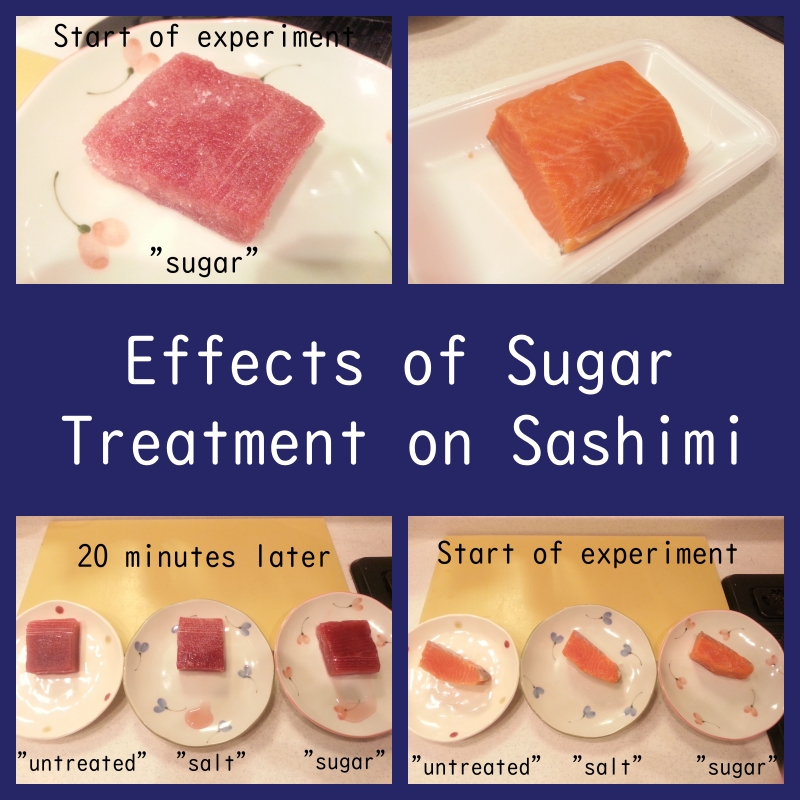
Sashimi Tuna and Salmon Sugar Treatment Conclusion
Let me conclude first. In this test, we tested “untreated”, “salt”, and “sugar”, and obtained the following results for both tuna and salmon.
Untreated
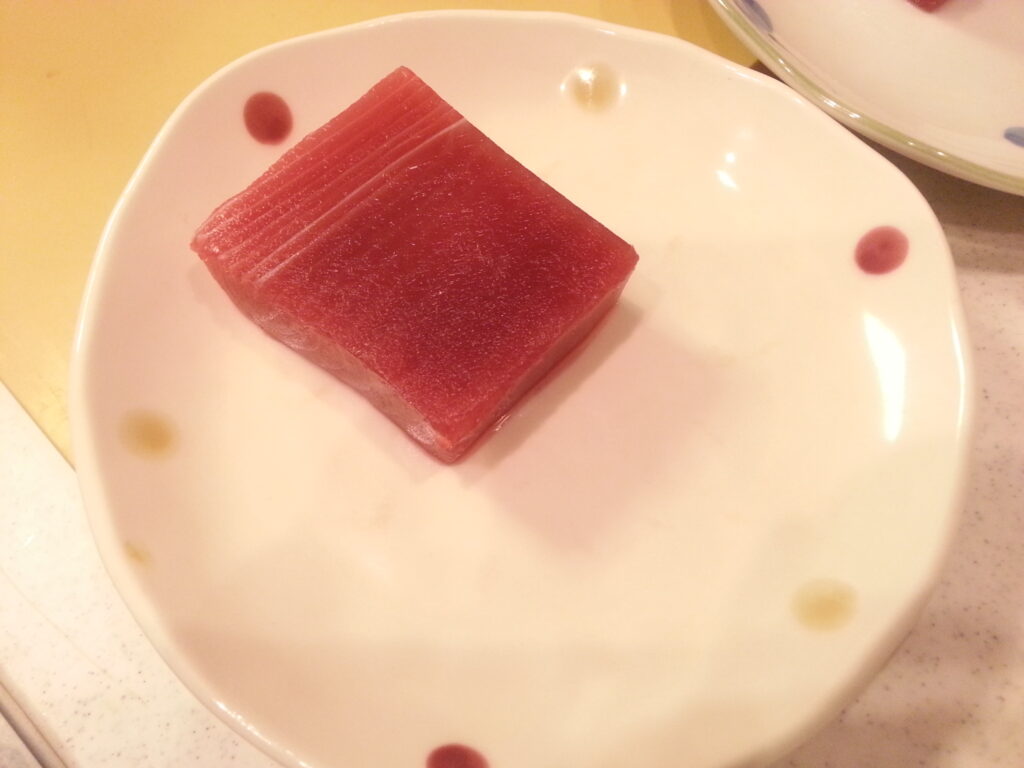
In this test, it is the standard taste. It is the sashimi we eat all the time.
Salt Treatment
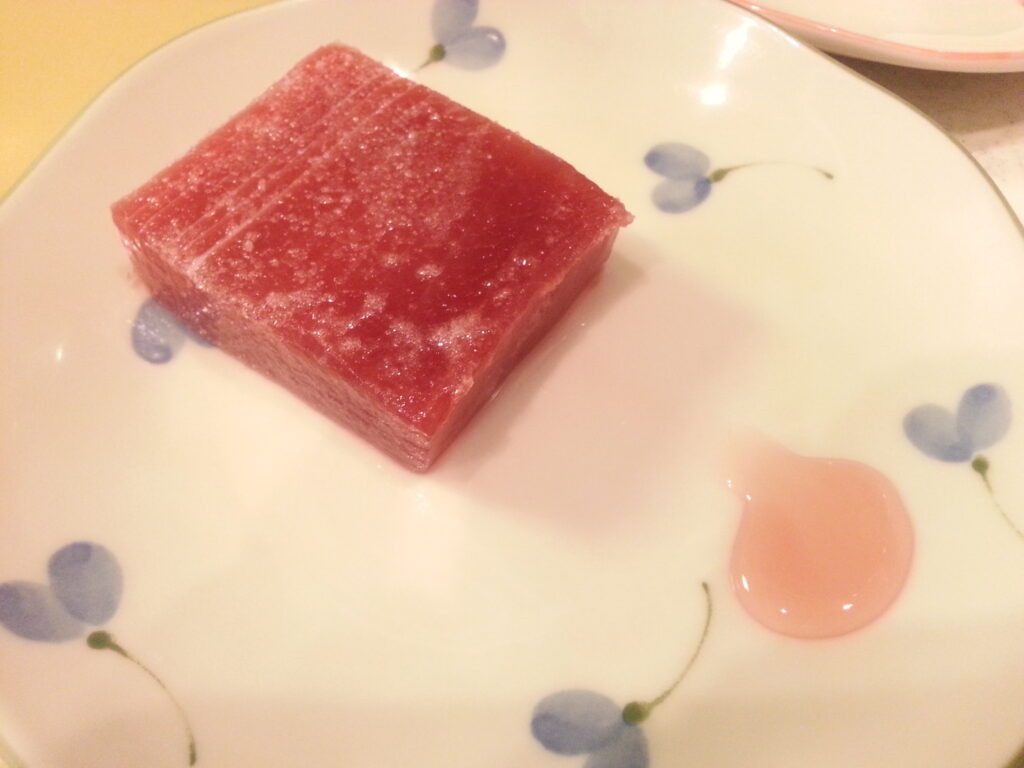
Along with being dehydrated and deodorized, the saltiness has been transferred to the tuna. When you eat it, you can feel the saltiness. Therefore, you do not need soy sauce to eat it. The dehydration gives the tuna a strong viscous texture. It is delicious eaten as it is, and I felt that it is also suitable for arranged dishes.
Sugar Treatment
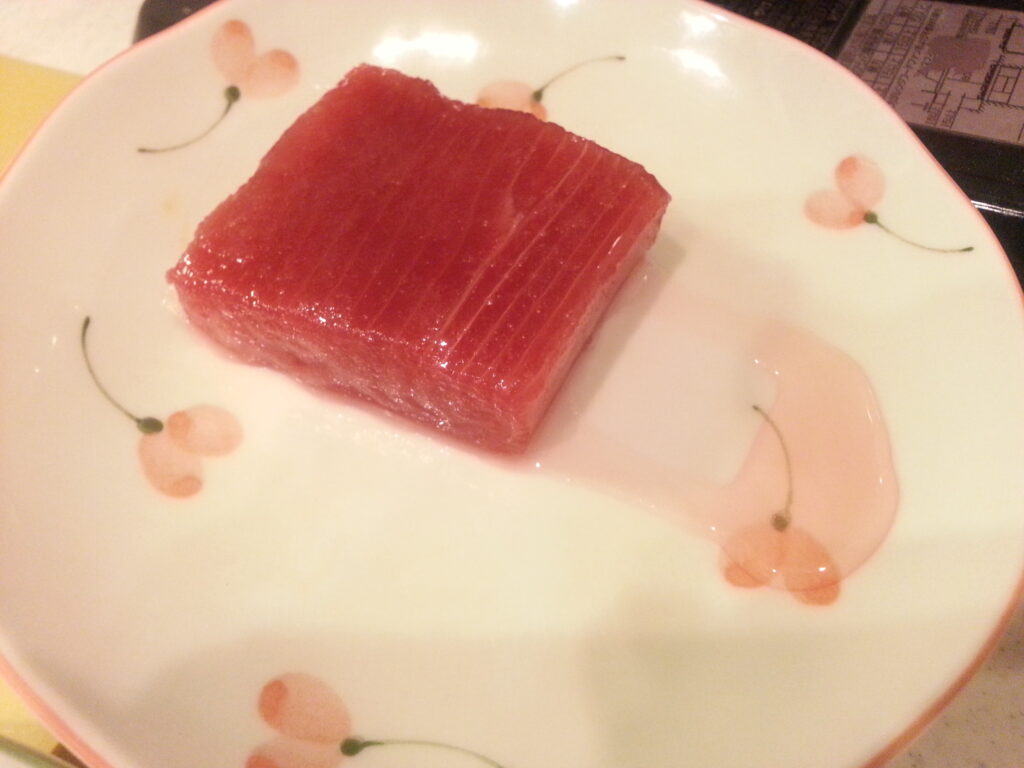
Dehydration and deodorization effects were obtained as well as salt tightening. What is unique is the taste. The saltiness of the “salt” is transferred to the sashimi, but in the case of the “sugar”, the effect of the taste is relatively small. In other words, the taste of sugar is less noticeable.
This allows the taste of the food itself to be strongly felt, in addition to the viscosity and odor removal. In this state, it can be served with soy sauce as usual, and it seems richer than when eaten normally. The effect of removing the smell was the same as that of the salt.
The reason why the taste of sugar is less affected by soy sauce than that of salt is that sugar has a large molecular weight, which makes it difficult to penetrate into the food.
Comparison of Tuna and Salmon
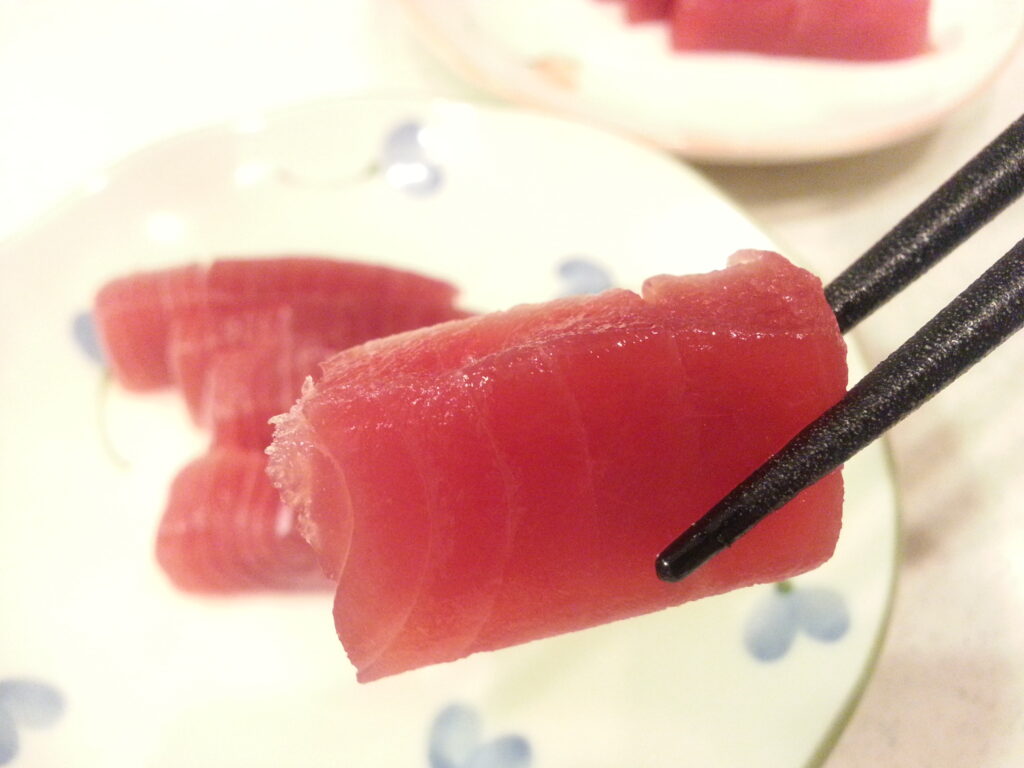
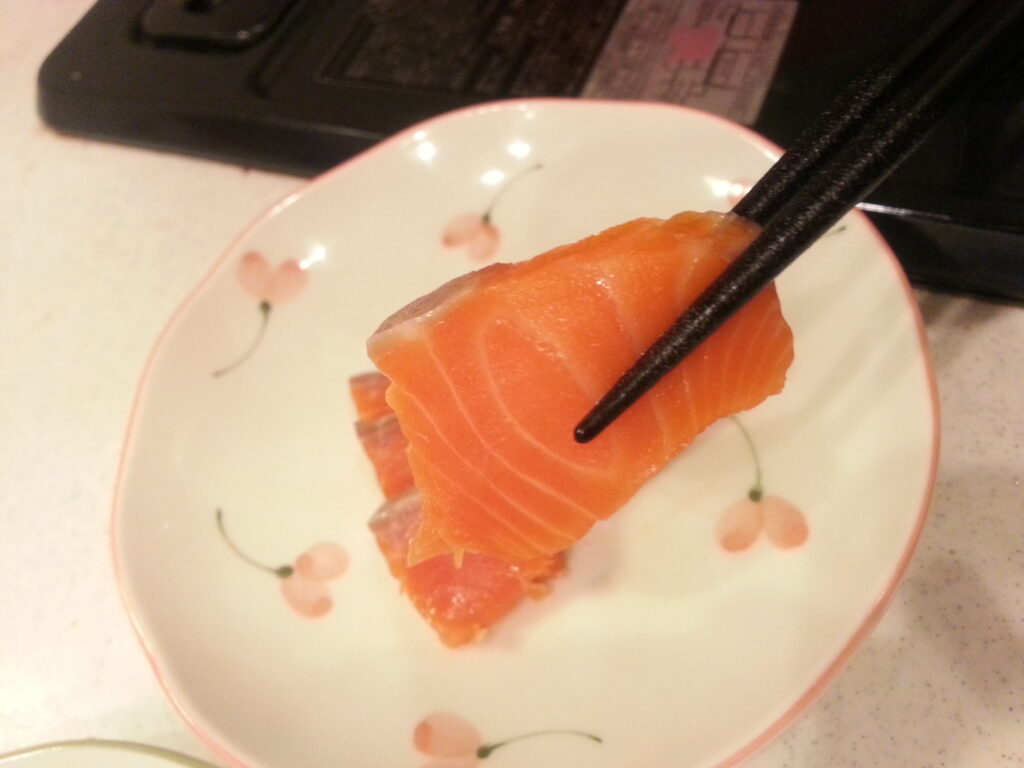
Compared to red tuna, salmon originally has less odor, so the effect of tightening (odor removal) is more easily felt with tuna. We feel that the value of implementing this method is greater for red tuna.
Sashimi Sugar Treatment Test Process and Results
Tuna
The material used is lean yellowfin tuna. Use red meat because fatty toro (belly) has less water and is less likely to produce the dehydration effect. Conversely, tightening up the red meat makes it tastier!
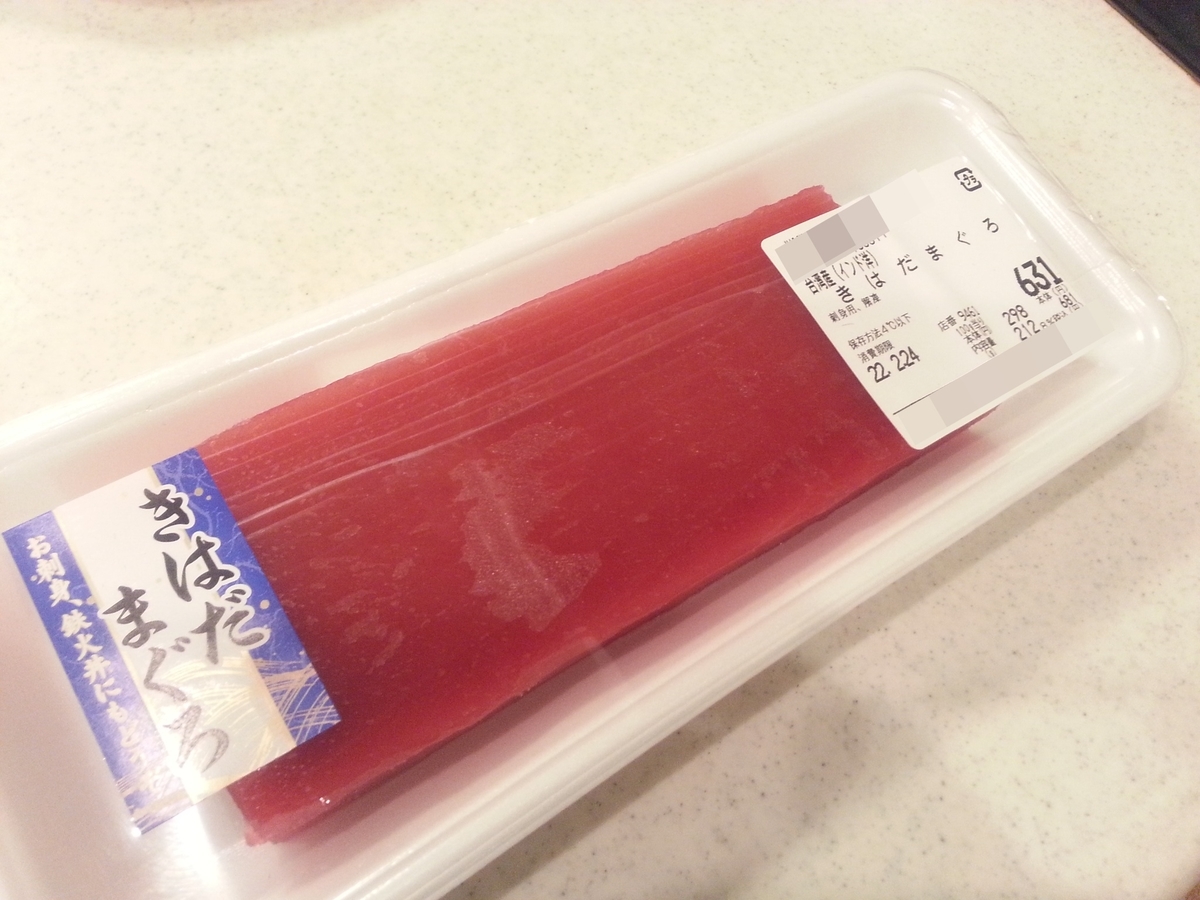
I divided them into three samples: “untreated” “salt,” and “sugar. I tilted the plate slightly so that the drippings would not remain on the surface.
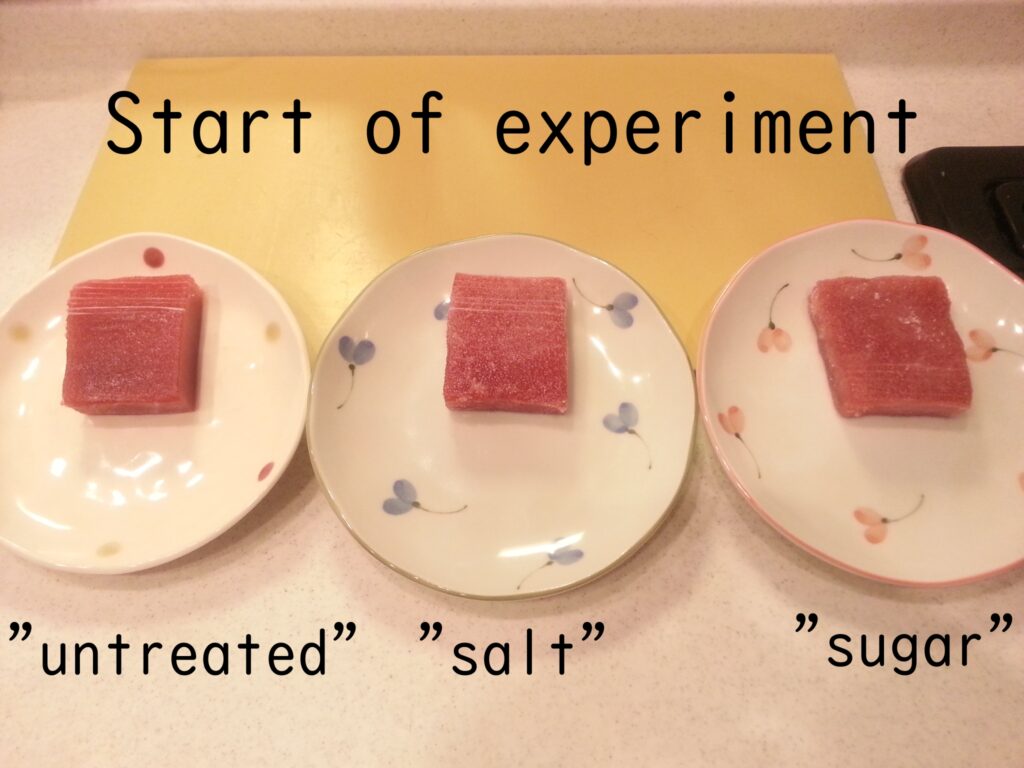
Now let’s start the experiment! Let me show you each condition. First, “untreated”.
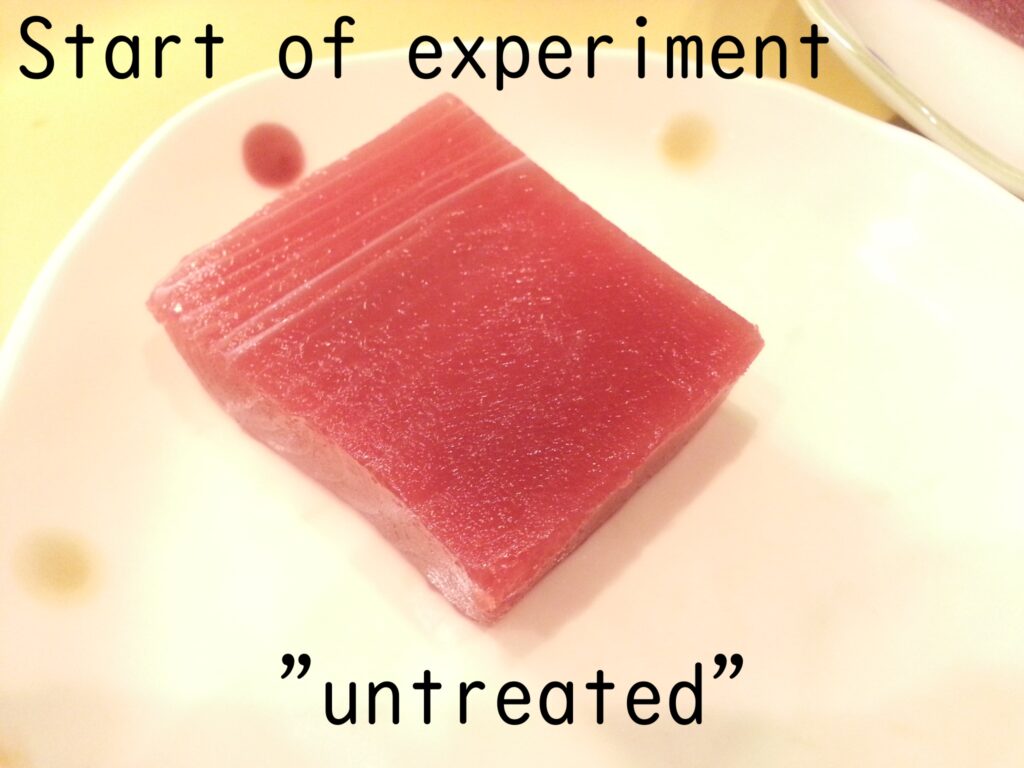
Next, the ‘salt’. I salted it evenly and strongly.
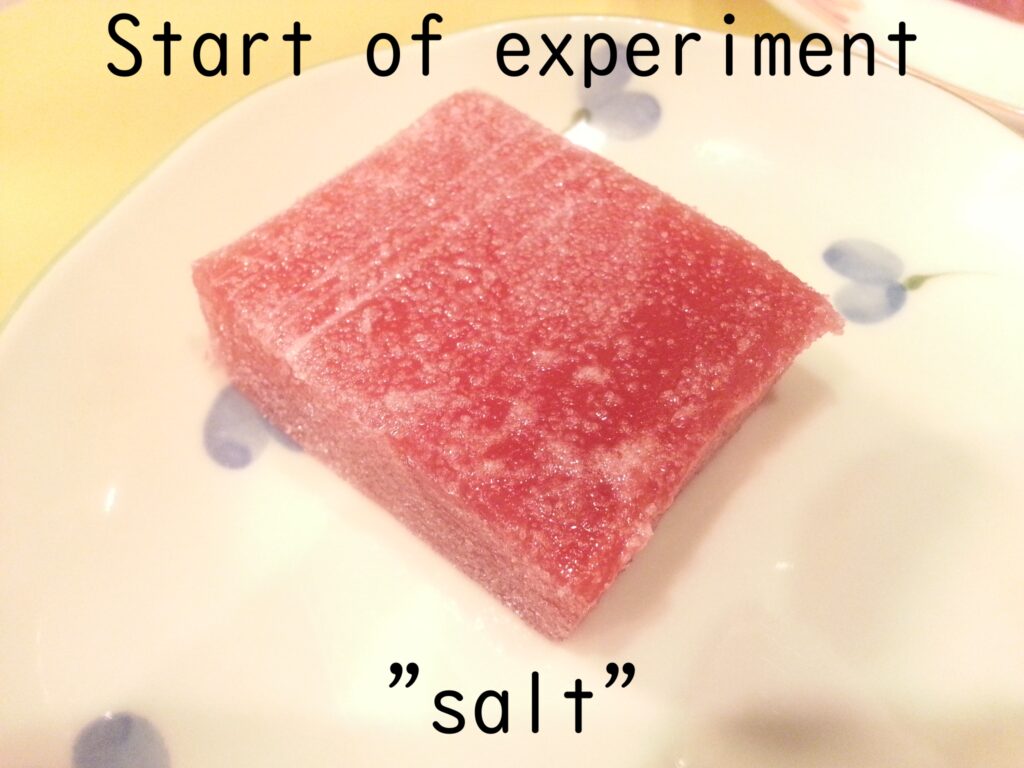
Finally, “sugar”. I use common white sugar. This is also uniformly and strongly covered with sugar.
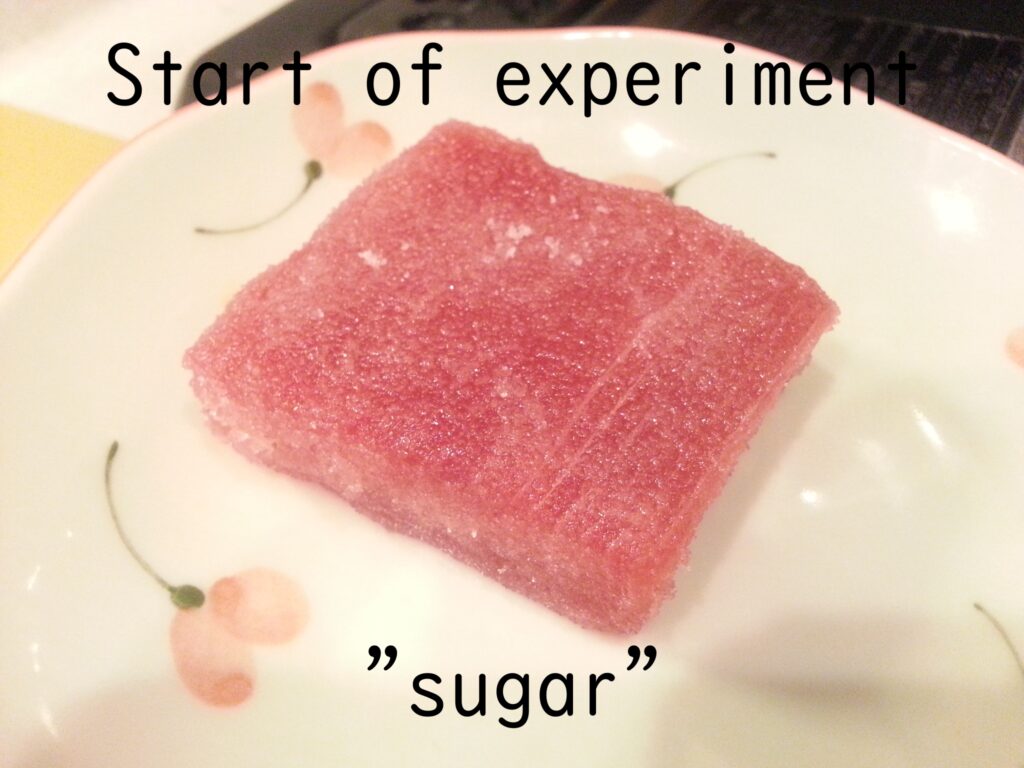
Observe the patient in this state for 20 minutes.
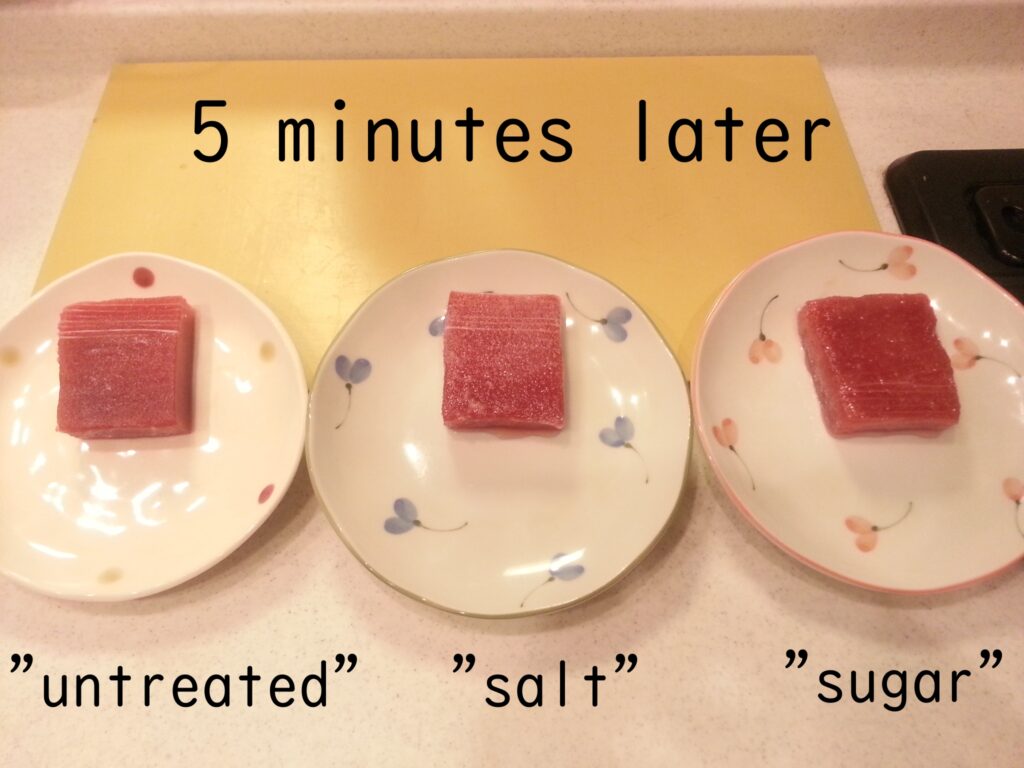
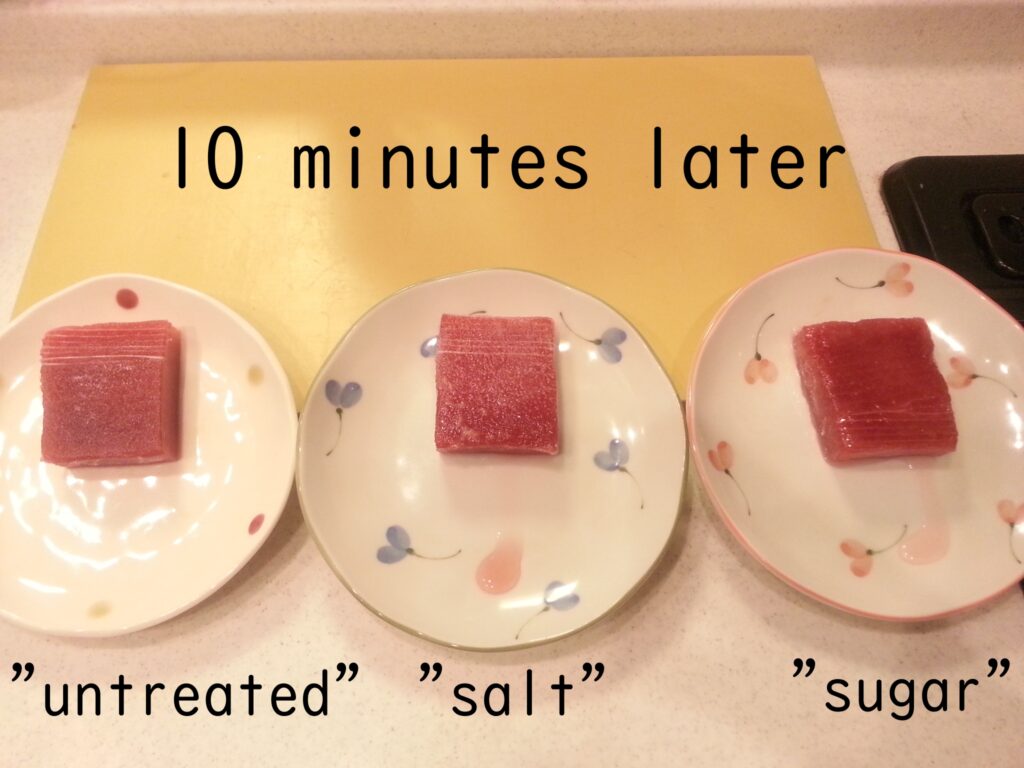
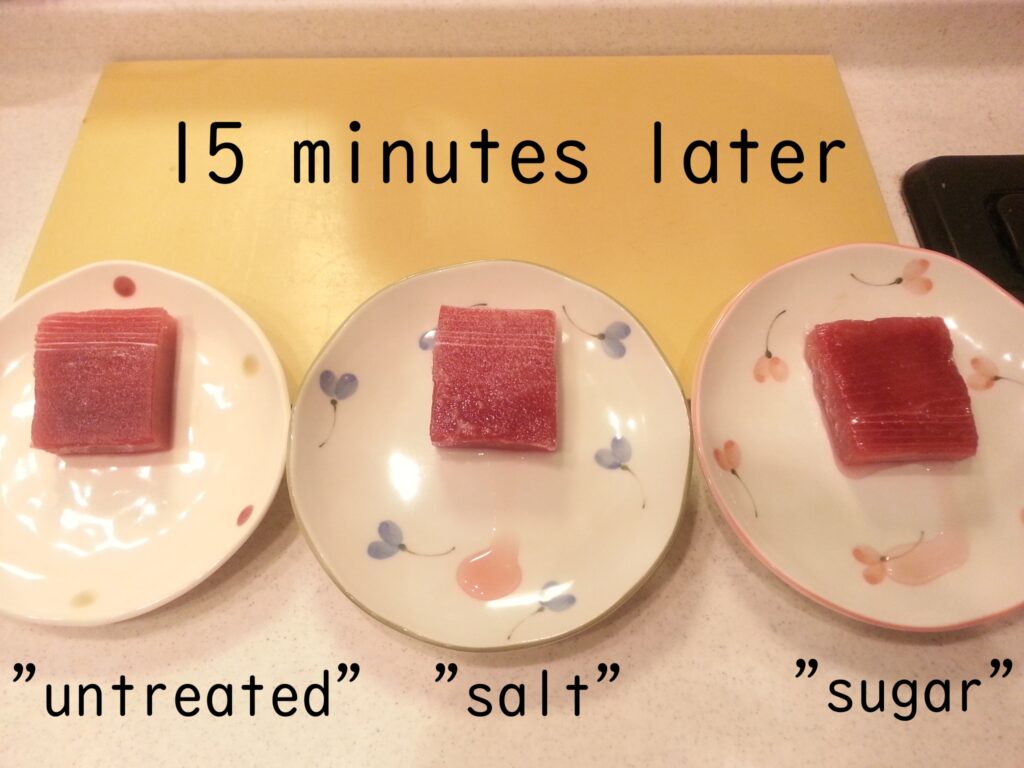
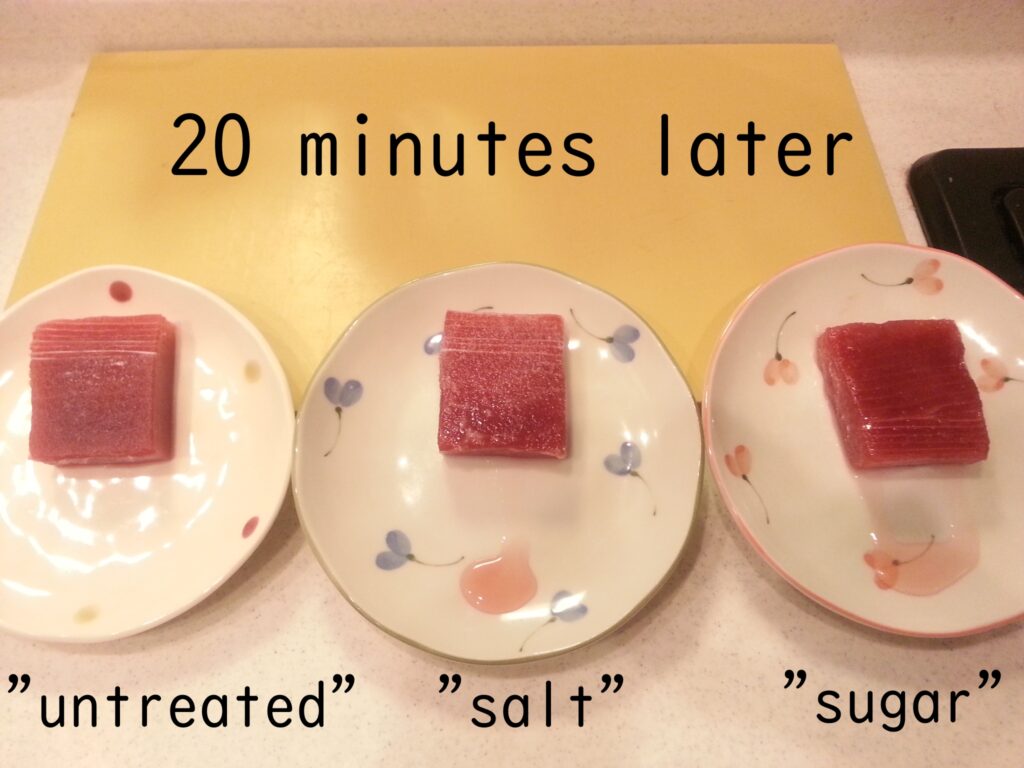
▼Then 20 minutes have elapsed. Let’s take a look at the state of each of them.
First, “untreated”. A thin layer of drippings is coming out, but not so much that it drips.
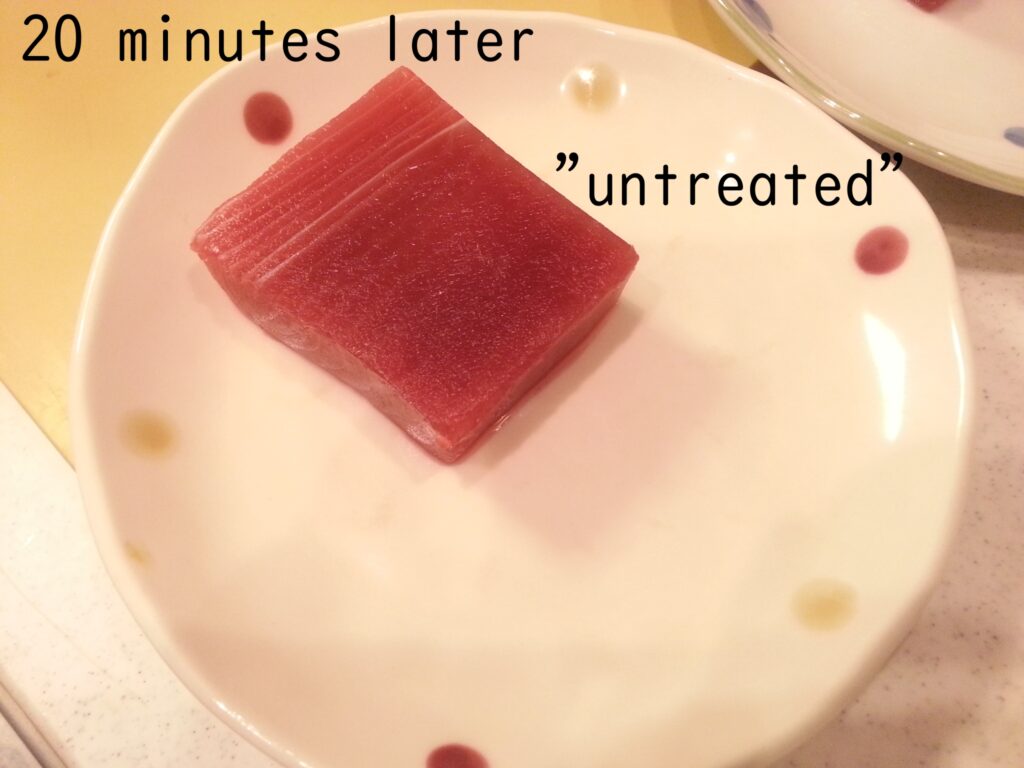
Next, “salt”. You can see that the salt is causing the water to drain out. You can see that it has accumulated under the plate.
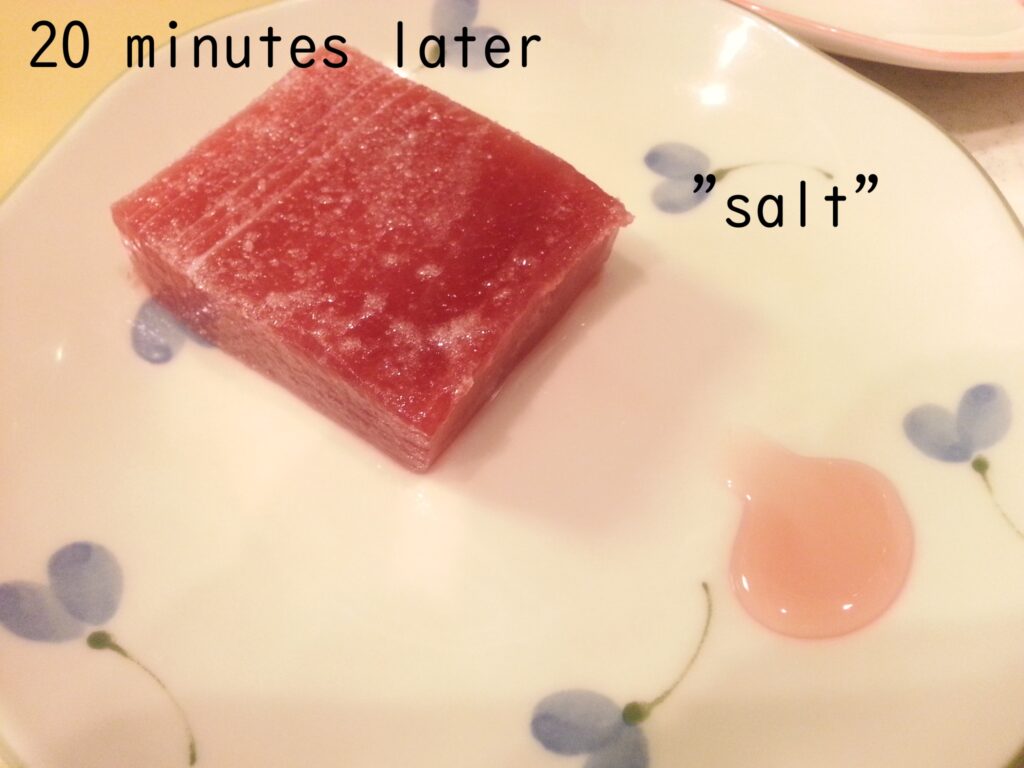
Finally, “sugar”. Compared to salt, we can see that no sugar particles remain. This is thought to be due to the higher solubility of sugar in water. Therefore, more water is also released.
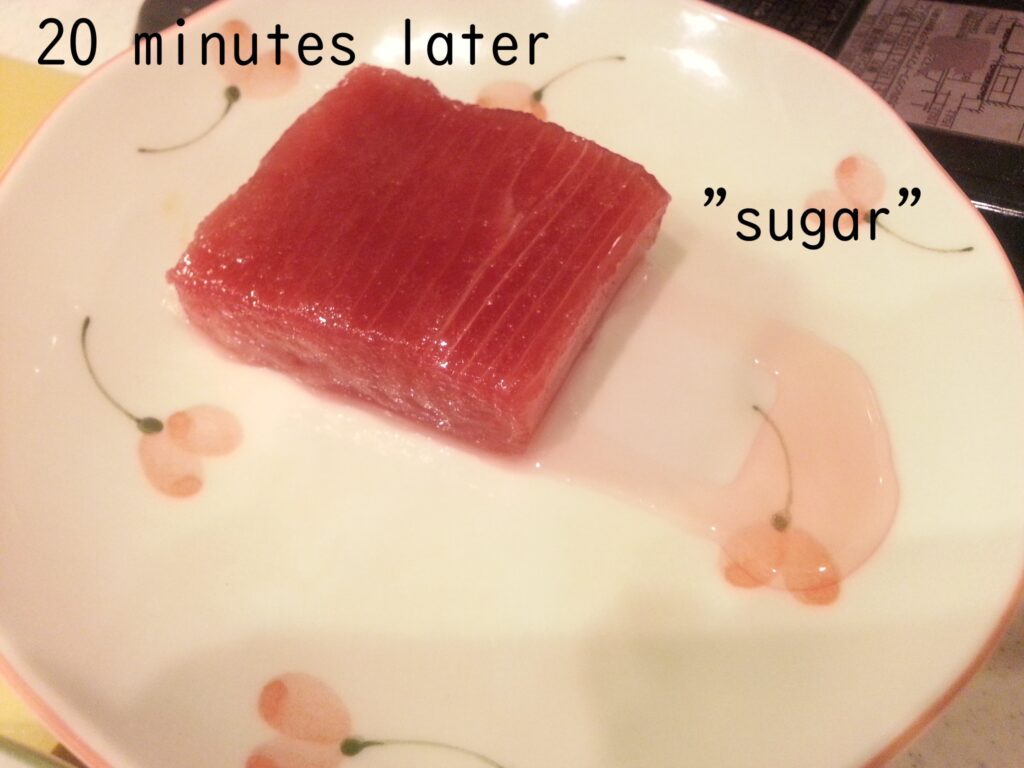
The weight change is also shown for reference. The results are shown after each piece is lightly flushed with running water and the water is thoroughly wiped off. It can be seen that dehydration is accelerated not only by “salt” but also by “sugar.
| Sample | ①Start | ②20 min later | Reduction(①-②) | |
| g | g | g | % | |
| “untreated” | 68.3 | 67.5 | 0.8 | 1.2 |
| “salt” | 70.1 | 68.4 | 1.7 | 2.4 |
| “sugar” | 71.3 | 69.3 | 2.0 | 2.8 |
Let’s taste each of them. What are the differences in taste?
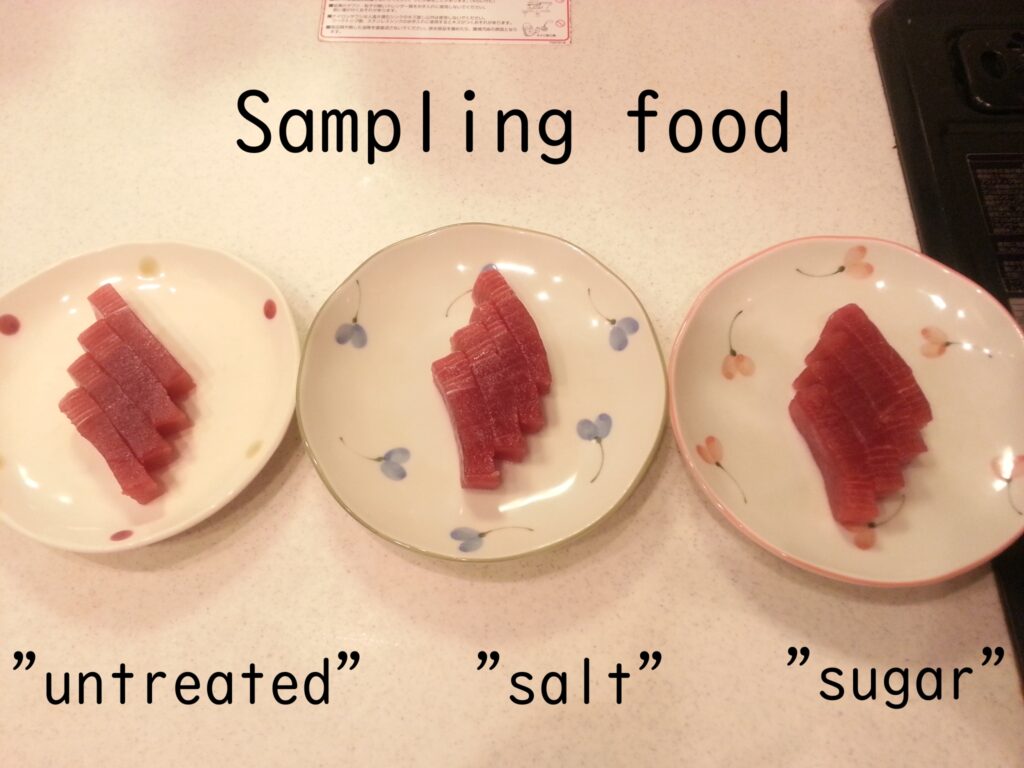
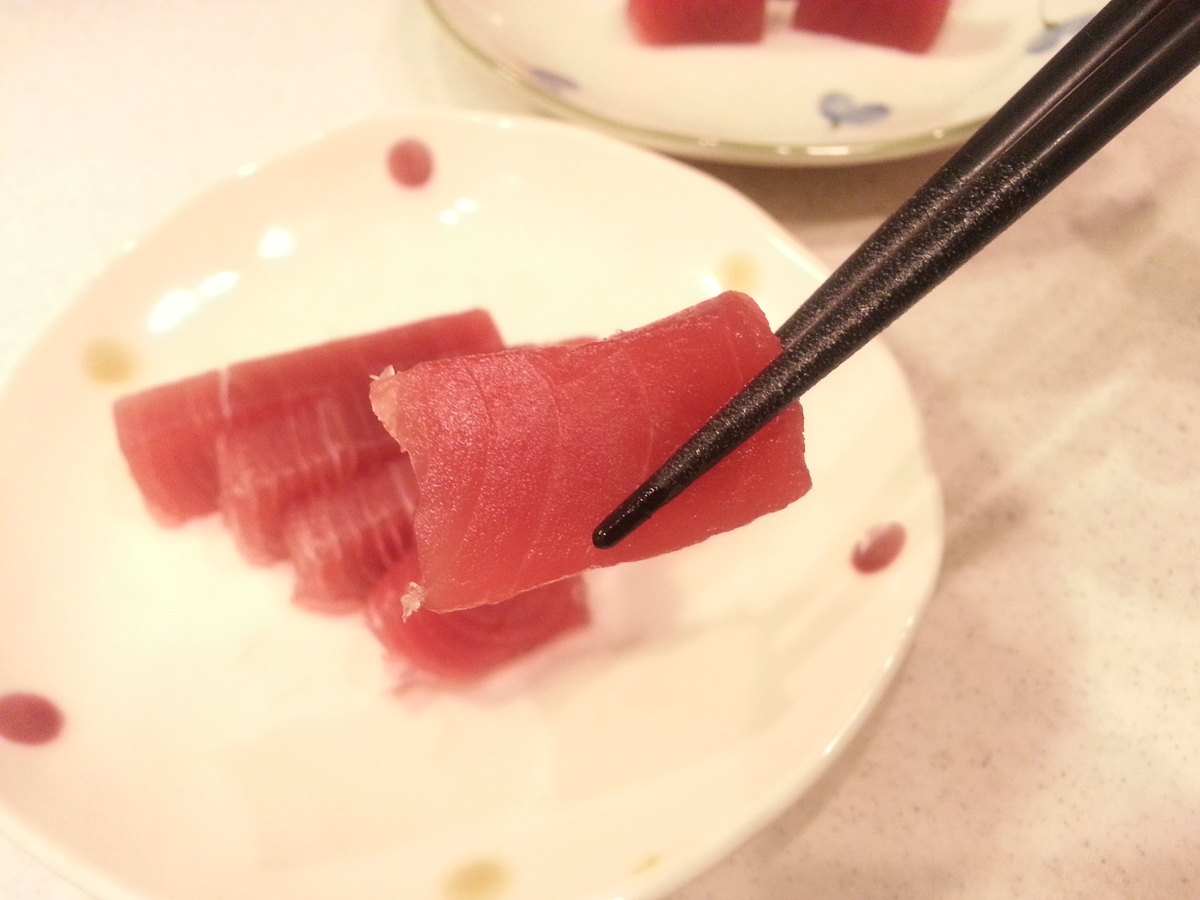
 じんた
じんたThe texture of “Salt” is viscous and buttery. And it tastes salty.
 じんた
じんた“Sugar” also has a viscous and buttery texture. It is characterized by the fact that the taste of sugar is not strong. Compared to “untreated”, the smell is noticeably less. The smell is removed and the texture is better! This is a good thing!
Salmon
Next, I will report the results of the salmon test, and the results are similar to those of the tuna. The difference is that salmon itself does not have much odor, so I felt that the effect of “sugar treatment” would be lower than that of tuna lean meat.
▼ I used sashimi salmon from Chile.
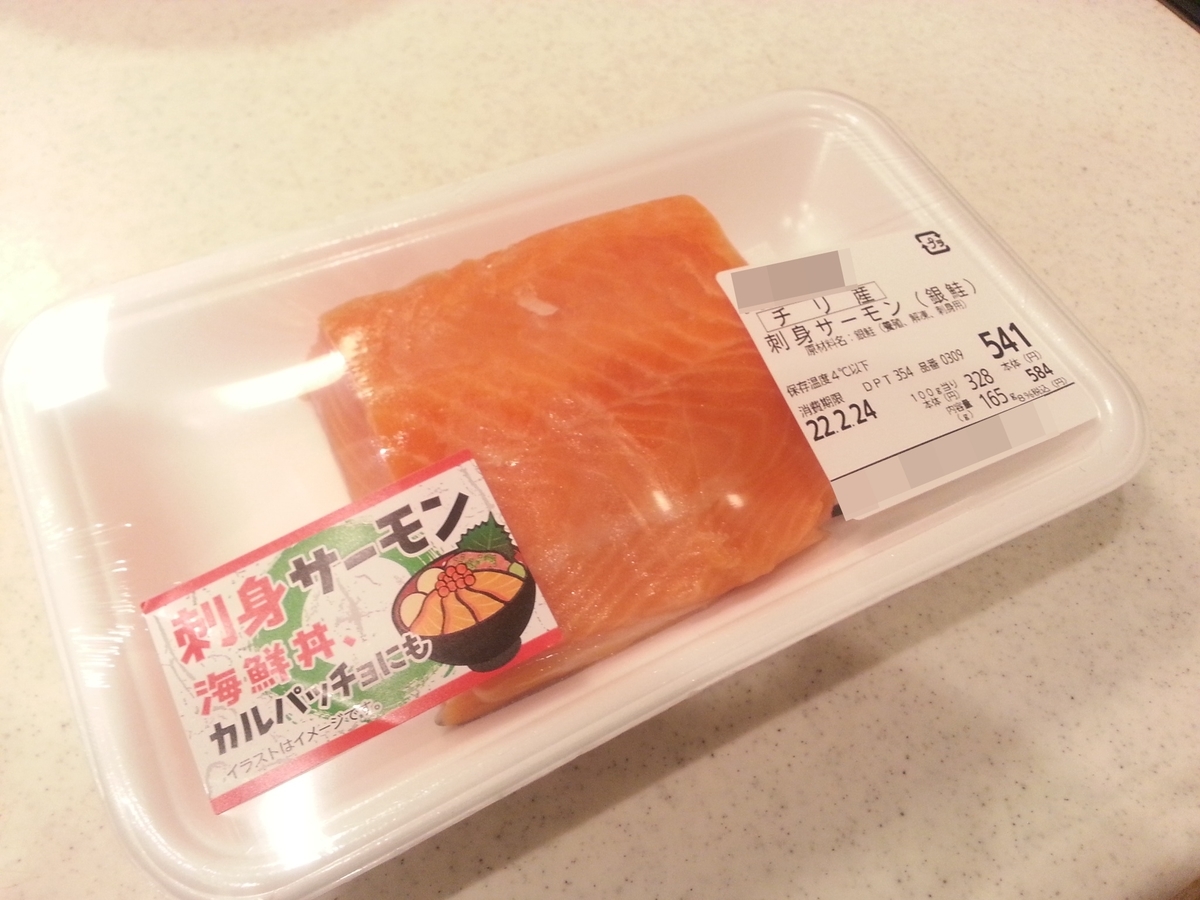
Now I will proceed with the test in the same way as for tuna red meat.
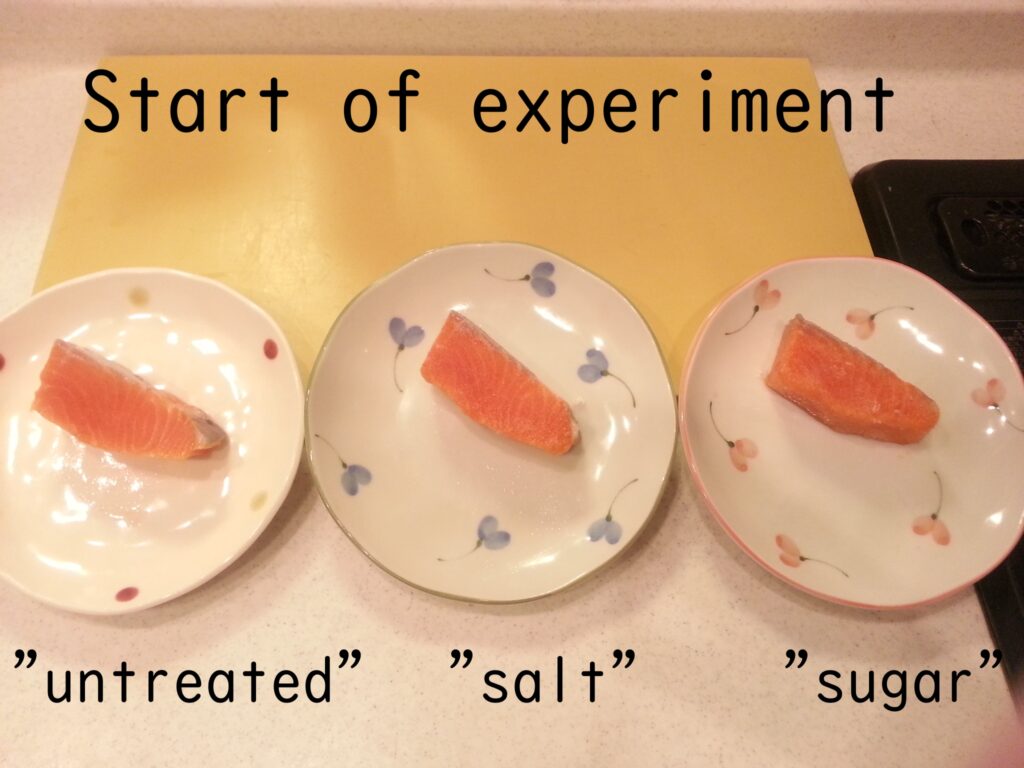
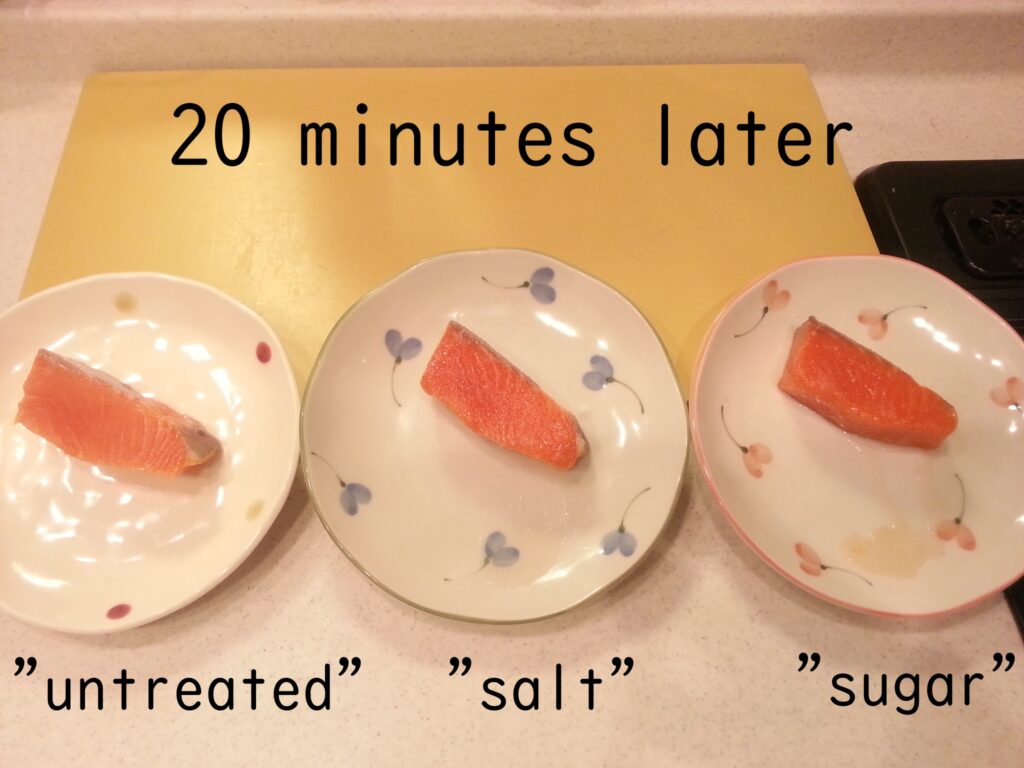
▼These are the respective states after 20 minutes.
First, “untreated”.
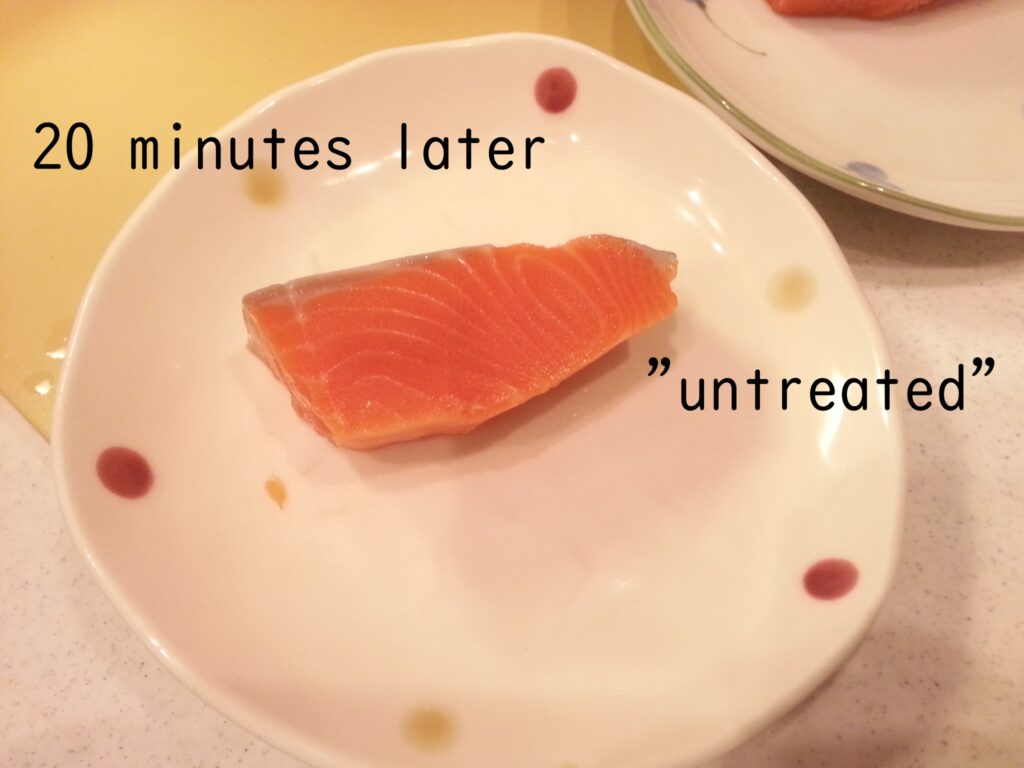
Next, “Salt”. The drippings are a little dripping. As with the tuna, there are more particles of “salt” left than in the “sugar”.
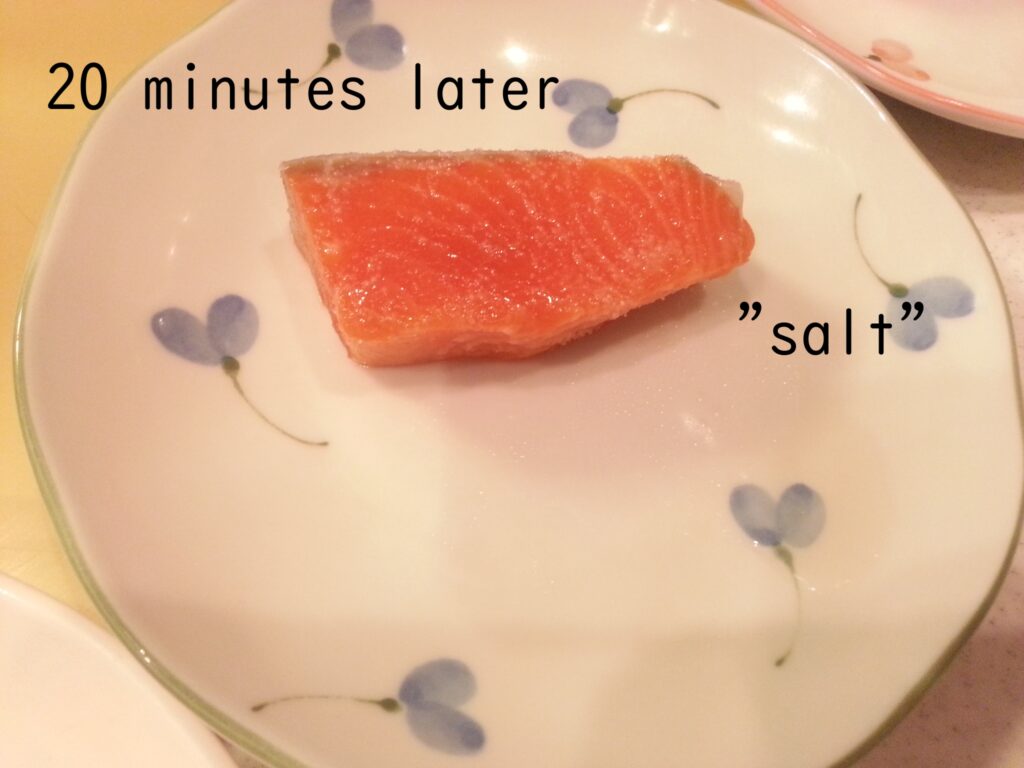
Finally, ‘sugar’. Sugar particles are gone and more drips are produced.
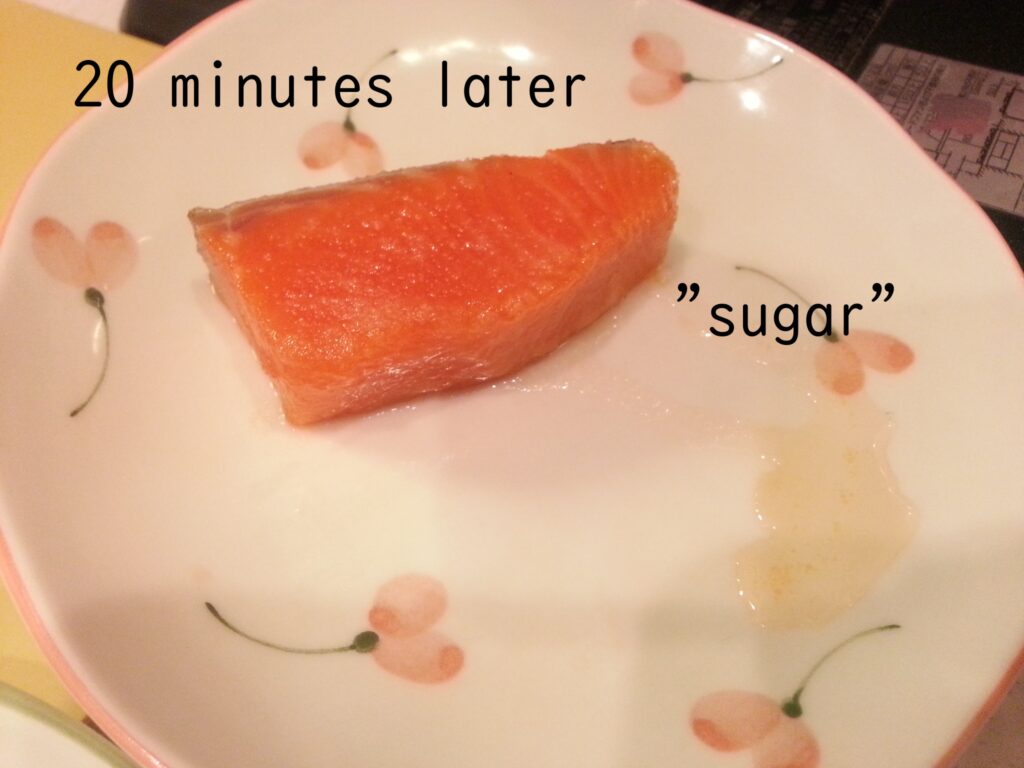
The weight change is shown. As with tuna, the dehydration effect was confirmed for both “salt” and “sugar. It can also be seen that “sugar” has lost more water than “salt”.
| Sample | ①Start | ②20 min later | Reduction(①-②) | |
| g | g | g | % | |
| “untreated” | 51.3 | 50.6 | 0.7 | 1.4 |
| “salt” | 53.7 | 52.6 | 1.1 | 2.0 |
| “sugar” | 52.7 | 50.9 | 1.8 | 3.4 |
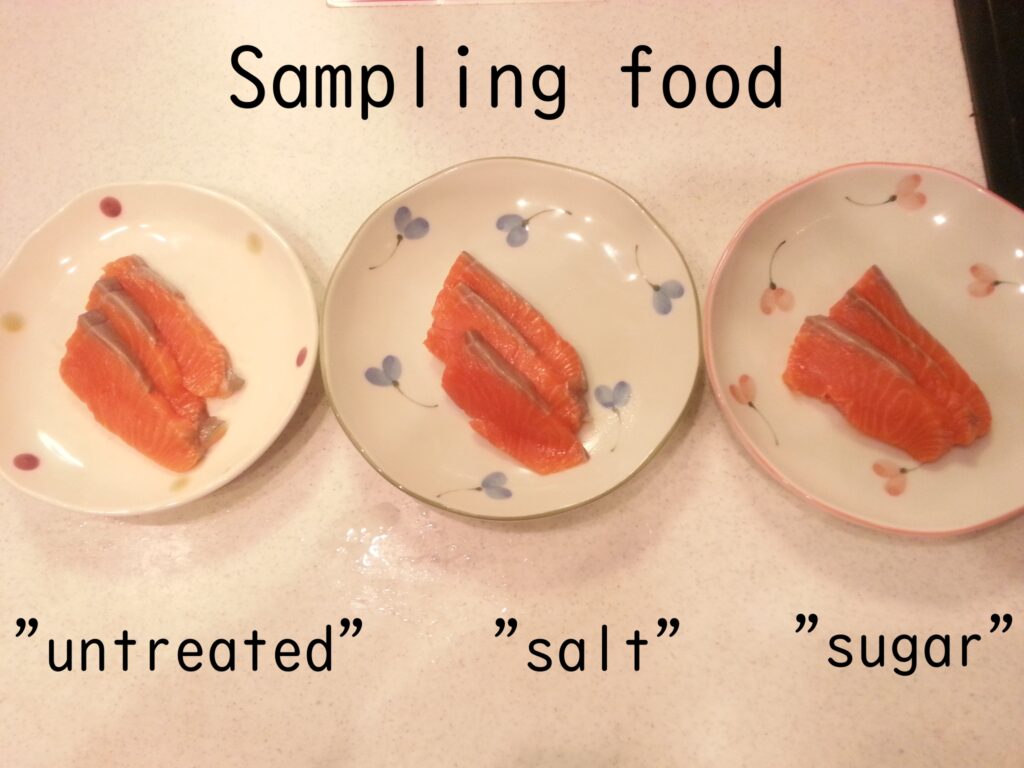
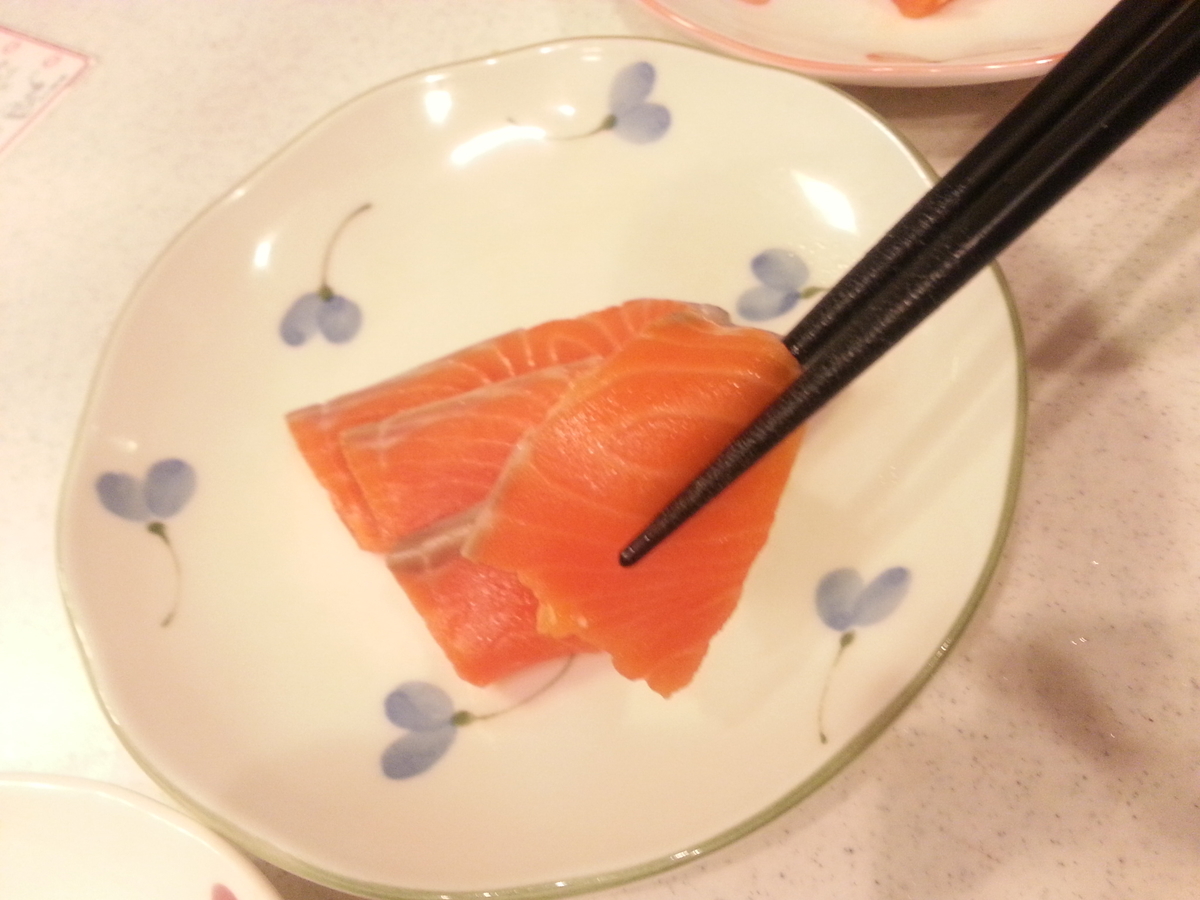
 じんた
じんたIt’s the same result as tuna. The “salt” has more texture and a stronger salty taste.
 じんた
じんた“Sugar” is not as sweet as I would like it to be. The taste of the salmon itself is concentrated. Compared to tuna, the salmon has less odor, so it is difficult to feel the effect of removing the odor.
▼ This is the result of this test with “sugar”, but for even greater results, there is a way to use dehydrated sheets for food products. If you are interested, please refer here.
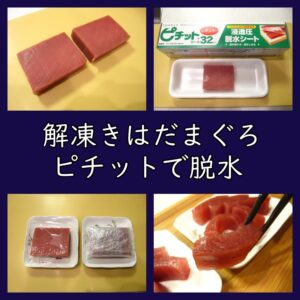
=スポンサーリンク=
Summary
In this issue, I tested and discussed the value of “Sugar treatment” on Sashimi fences using Sashimi Tuna and Salmon. It is possible to apply “Sugar treatment” to Sashimi when you want to experience a richer flavor of the ingredients of Tuna and Salmon! I felt that it was a good idea. It removes the smell and increases the viscous and buttery of the texture. How do you feel about it? Please give it a try.
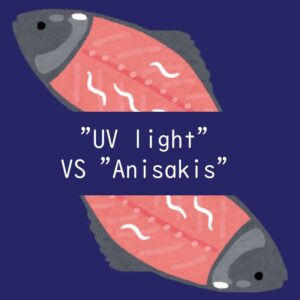
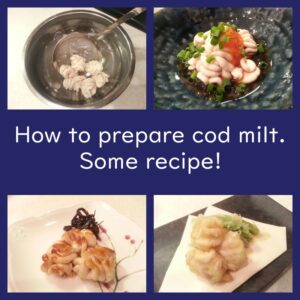
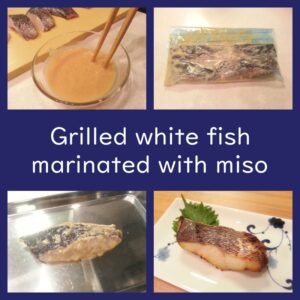

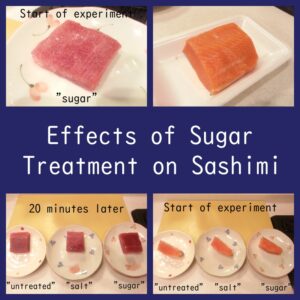
コメントお願いします(※は必須項目)